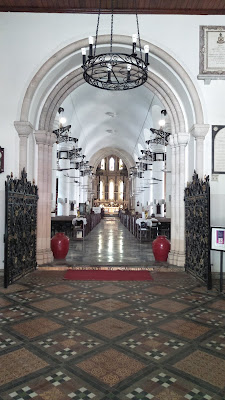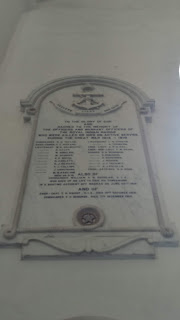The view from the doorway
A plaque commemorating Cobbe, below which, a plaque put up when the church was rededicated, 2003, after restoration
The Cathedral served as the primary place of worship for the English stationed in Bombay from the year 1718 onward. It also serves as zero-point for the city, when measurements were taken. The exact spot in the church premises is commemorated with a plaque.
The Zero point plaque
The walls, covered with plaques
The stained glass. I later read that a replaced panel sports an image of a local train and churchgate station!
Quite a few ships were wrecked in storms off the coast. This one commemorates those who died in the wreck of 'Cleopatra', in 1847 off the Malabar coast
A few of those remembered here are:
- Thomas Carre, he first Bishop of Bombay. He has a life-size statue of himself, lying down, with a plaque below, right beside the alter
The grave of Carr, died 1859
- Lucretia Georgiana Brown West, the Widow of a Chief Justice of Bombay, died 1828
- A memorial to all those in the Royal Indian Marine who died in World War I
- A memorial to all those from Bombay who died in World War I
- Captain Leiutenant George Warden, who was involved in various military activities, from 1794 -1807. These activities involved his first duties against the Coolies under Colonel Little(was this a revolt he subdued?) in 1794, to taking Colombo(1796), to the battle of Sedasheer, to the battle of Seringapattinam, to the destruction of the fortress of Jemaulabad (all in 1799), the expedition to Egypt (1801) and the Seige of Baroda(1803). In 1807, H Newham, Secretary to the Government publishes the condolence message that appears on his epitaph, in the Asiatic Annual Register, 1808.
- Henry Curwen, Editor, Times of India, who died 1892 on the way back to England. He had bought the newspaper in 1890, in association with Charles Kane. It was sold in 1792.
- Sir William Syer Knight, the first Recorder, or Kings Justice, of Bombay. Barrister at Law of the Society of Middle Temple, he died 1802
- Thomas Mostyn, a Resident at the Mahratta Court, died 1779.
- Robert Ashmead Billamore, who, apart from his military duties was Persian interpreter to the Poonah subsidiary force. A son of a noted General, he died in the 1818 war against the Mahrattas at Jaulnah, 7th May.
- Colonel John Campbell, who held Mangalore against the armies of Tippu Sultan for 18 months. He died in 1784.
- Hon. Jonathan Duncan, the Governor of Bombay from 1795-1811. He was appointed there as recognition for having abolished Infanticide in Benares and Kathiwar. He died 17th August 1811 in Bombay. The monument here was built out of public respect in 1817
- Major Eldred Pottinger, one of those few people actually buried in the Cathedral. Made a hero when, in 1837, he provided intelligence to the British at Kabul on the Seige of Herat by the Persians, with Russian aid. He was within Herat and disguised. Afterwards, he was made famous by the British as 'The Hero of Herat'. Just before the revolt at Kabul, in 1841, he had arrived at Charikar and encamped with a Gurkha regiment, North of Kabul. On 3rd November, the uprising began, and the following night, they fought their way to the garrison at the base of the hill. After two weeks they made their way to Kabul, which only he and one other reached on 15th November. After the death of the British envoy, Sir William McNaghten, he was appointed British envoy to the Afghan court, and negotiated a withdrawal. However, while retreating many died from the cold and the Afghanis who followed them and shot at them from the high mountain passes. The ruler of Kabul, Akbar Shah, then took hostage all the women and injured, including Pottinger, and due to this, he survived the following massacre. Taken to the Bamiyan fort during the counter-attack by fresh British troops from the Presidencies, he connived with his captors, and took control of the fort. Once released and, returning to India, he received no rewards or mention, and resigned from the Company. He went to Hong Kong, where his uncle was the first British governor, and died there in 1843, a little over a year later.
One among the famous masses, hidden behind chairs, this was the best view I could get
The Cathedral received heritage status in 2003.
It is now maintained extremely well, and is a part of Bombay's living heritage. Open throughout the day, from 7-6, it is definitely a must-see if you are looking at Bombay's heritage, or architecture. Though quite a silent place, the history within it is loud, and reverberates.
Location, here
Location, here
The pulpit
The Baptismal font
A model of the church
The fountain and the entrance

























Loved your finishing lines...
ReplyDeleteThanks
DeleteFabulous. Thank you
ReplyDeleteThanks :)
DeleteThis comment has been removed by the author.
ReplyDeleteLovely, Nandan. Almost felt like I was there, reading the plaques.
ReplyDelete😊
DeleteWell written !
ReplyDeleteThank you for sharing this precious history. Would love to read something on the Afghan Church, and anything else that you choose.
ReplyDeleteWill be writing on a few more from this bombay trip, soon!
ReplyDelete